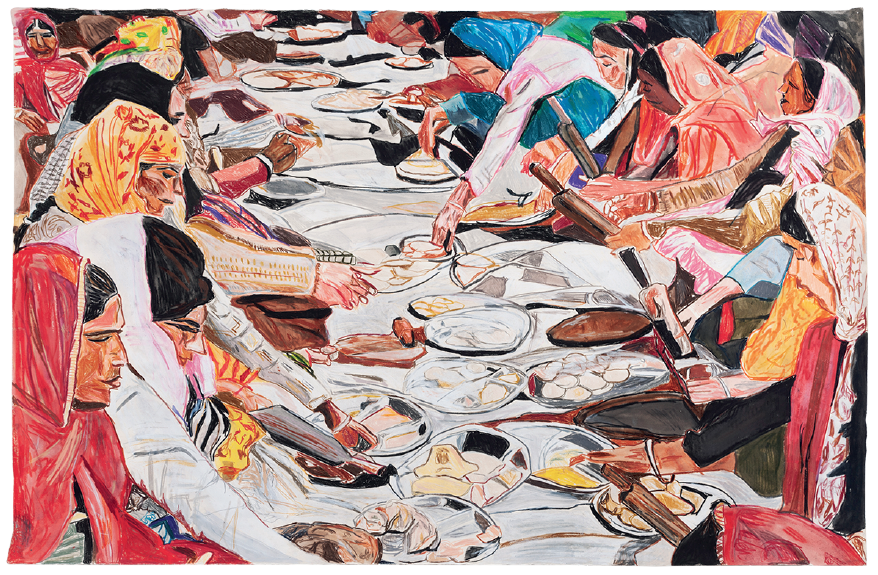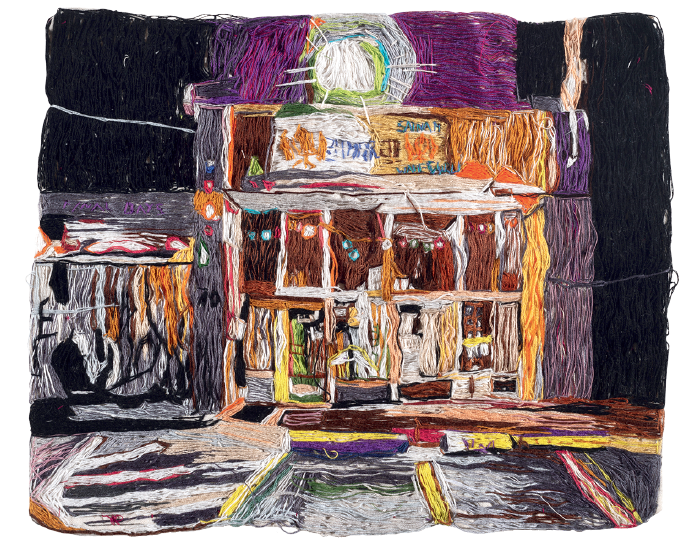Jagdeep Raina
There is a subway-tiled sanctuary in the Lower East Side, where East 1st Street dips into East Houston. Below an unassuming green awning, Punjabi Grocery & Deli offers 24-hour refuge. Founded by a former taxi driver in 1993, the deli provides spicy samosas, a choice of curries in metal trays, rounds of sweet ladoo, hot chai in blue and white paper cups that read, “It is our pleasure to serve you,” twopacks of Advil, a restroom and a stoop out front. At about five dollars a plate, the deli’s curries are good enough for New York’s food critics and a steady stream of its estimated 13,000 South Asian taxi drivers looking for a break and taste of home. Canadian Sikh artist Jagdeep Raina (b. 1991) visited Punjabi Deli regularly while completing his MFA at the Rhode Island School of Design, and in his solo exhibition, “Chase,” at the Art Gallery of Guelph, it is celebrated as an unconsecrated monument to Sikh diaspora, both generous and resilient in a land of rising xenophobia and gentrification.

Jagdeep Raina, Distributing Langar, 2019, mixed media on paper, 26 x 40 inches. Images courtesy Art Gallery of Guelph, Guelph.
A recent New York Times article calls Canada’s Sikh community the “embodiment of the Canadian Dream.” Raina’s paintings and embroideries report a less simplistic story, showing the labour the dream runs on in factories, gas stations, beer stores, delis and gardens. In one painting on paper, a woman works in a blackened factory room. The darkness around her is broken by blocks of primary blues, yellows and reds that summon Mondrian’s spiritual program. A message floats above her head: “YOUR MIGRANT LABOUR LEADING TO MY CLASS PRIVILEGE”—a testament to the manual labour that allows first-generation immigrants to provide for their children, the generation to which Raina belongs. In another piece, the factory headquarters are on fire. This refers to a real fire at Linamar, one of Canada’s largest automobile parts manufacturers, located in Raina’s native Guelph, but it also appears to be a jab at capitalism as untouchable.
Raina works from vernacular photographs he takes or finds in archives and family albums, documents of Sikh life in Canada and the US. His vignettes are realistic and focused, contemporary alternatives to Edward Hopper’s Americana. Unlike the solitary figures in Hopper’s paintings, seen from afar by an apparently neutral observer, Raina is invested in the relations that enliven the places he portrays. Scale and composition are always a little askew; the kind of distortion we experience as intimacy warms and warps our perception. In his paintings of Punjabi Deli, workers are seen across the counter as if by regular customers exchanging banter. In one embroidery, Memories of our vast lush, punjabi alluvial plains find themselves resurrected in these diasporic baghs, 2019, a Punjabi grandmother is in the green of her Canadian garden. We see her as a family member might, kneeling low to the ground with her hands in the earth.

Jagdeep Raina, Final Days, 2019, hand embroidery on muslin, 10 x 12 inches.
Raina documents work carried out by women’s hands in the garden, at the factory, in a loved one’s hair, serving a meal and threading cotton through muslin. He explains his use of embroidery as inspired by the textiles of his ancestors, the Kashmiri Shawl with its floral motifs, as well as the Punjabi Phulkari made from hand-spun, vegetable-dyed cotton. Raina’s family came to Canada from Punjab and Kashmir in the 1960s. His small embroideries are dense with thread and spill at the edges. In My mother’s punjabi rug, woven with nimrata, 2019, a woman’s face looks out lovingly from the centre. Her Punjabi rug fills most of the muslin—bright yellow and orange with dark blue and purple detail. Her intricate labour and Raina’s own interweave.
Nimrata means humility, a sensibility visible in the eyes of this figure and across the artist’s works, one by one. These hold an intersectional politics rooted in family and community from New York City to Guelph. The show’s title, “Chase,” is drawn from twin Canadian winterscapes in which Raina teases the myths that frame migrant labour. In one embroidery, a frozen yard holds a wooden box with “SCARCITY MINDSET L” scrawled across it in red thread, a spat of graffiti acting as a reminder of a pervasive and paranoid world view that makes the working class suspicious of migrants. This is paired with another embroidery, a bungalow home on a desolate winter’s day with “CHASE FOR MORE” stitched across the eavestrough in the same emergency red. The phrase might be a mantra for the so-called Canadian dream, shown here in full swing, looking awfully bleak. At Raina’s touch, irony, though abundant, is not dismissive. The words appear to be those of a son of immigrants arguing, with humility and gratitude, for clear-eyed, not romanticized, endurance. ❚
“Chase” was exhibited at the Art Gallery of Guelph, Guelph, ON, from May 23 to August 18, 2019.
Georgia Phillips-Amos is a British-American writer. She grew up in Málaga, Spain, and Long Island, New York, and has worked at Verso Books and New Directions.
To read the rest of Issue 152, order a single copy here.

